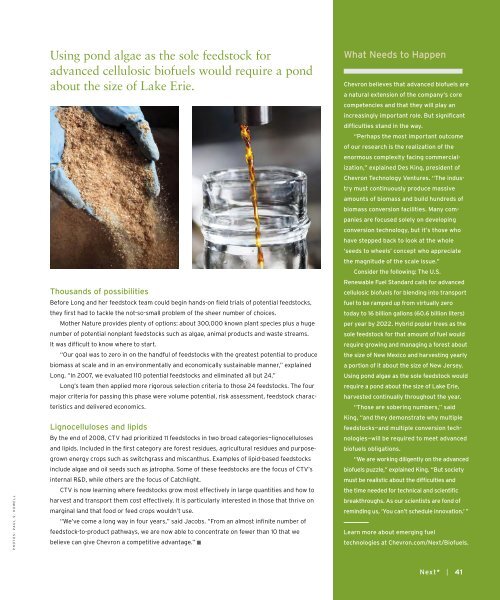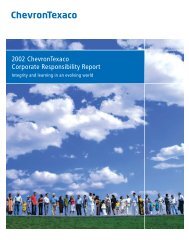Next* Magazine, Issue 4 - Chevron
Next* Magazine, Issue 4 - Chevron
Next* Magazine, Issue 4 - Chevron
- No tags were found...
You also want an ePaper? Increase the reach of your titles
YUMPU automatically turns print PDFs into web optimized ePapers that Google loves.
PHOTOS: PAUL S. HOWELLUsing pond algae as the sole feedstock foradvanced cellulosic biofuels would require a pondabout the size of Lake Erie.Thousands of possibilitiesBefore Long and her feedstock team could begin hands-on field trials of potential feedstocks,they first had to tackle the not-so-small problem of the sheer number of choices.Mother Nature provides plenty of options: about 300,000 known plant species plus a hugenumber of potential nonplant feedstocks such as algae, animal products and waste streams.It was difficult to know where to start.“Our goal was to zero in on the handful of feedstocks with the greatest potential to producebiomass at scale and in an environmentally and economically sustainable manner,” explainedLong. “In 2007, we evaluated 110 potential feedstocks and eliminated all but 24.”Long’s team then applied more rigorous selection criteria to those 24 feedstocks. The fourmajor criteria for passing this phase were volume potential, risk assessment, feedstock characteristicsand delivered economics.Lignocelluloses and lipidsBy the end of 2008, CTV had prioritized 11 feedstocks in two broad categories—lignocellulosesand lipids. Included in the first category are forest residues, agricultural residues and purposegrownenergy crops such as switchgrass and miscanthus. Examples of lipid-based feedstocksinclude algae and oil seeds such as jatropha. Some of these feedstocks are the focus of CTV’sinternal R&D, while others are the focus of Catchlight.CTV is now learning where feedstocks grow most effectively in large quantities and how toharvest and transport them cost effectively. It is particularly interested in those that thrive onmarginal land that food or feed crops wouldn’t use.“We’ve come a long way in four years,” said Jacobs. “From an almost infinite number offeedstock-to-product pathways, we are now able to concentrate on fewer than 10 that webelieve can give <strong>Chevron</strong> a competitive advantage.” ■What Needs to Happen<strong>Chevron</strong> believes that advanced biofuels area natural extension of the company’s corecompetencies and that they will play anincreasingly important role. But significantdifficulties stand in the way.“Perhaps the most important outcomeof our research is the realization of theenormous complexity facing commercialization,”explained Des King, president of<strong>Chevron</strong> Technology Ventures. “The industrymust continuously produce massiveamounts of biomass and build hundreds ofbiomass conversion facilities. Many companiesare focused solely on developingconversion technology, but it’s those whohave stepped back to look at the whole‘seeds to wheels’ concept who appreciatethe magnitude of the scale issue.”Consider the following: The U.S.Renewable Fuel Standard calls for advancedcellulosic biofuels for blending into transportfuel to be ramped up from virtually zerotoday to 16 billion gallons (60.6 billion liters)per year by 2022. Hybrid poplar trees as thesole feedstock for that amount of fuel wouldrequire growing and managing a forest aboutthe size of New Mexico and harvesting yearlya portion of it about the size of New Jersey.Using pond algae as the sole feedstock wouldrequire a pond about the size of Lake Erie,harvested continually throughout the year.“Those are sobering numbers,” saidKing, “and they demonstrate why multiplefeedstocks—and multiple conversion technologies—willbe required to meet advancedbiofuels obligations.“We are working diligently on the advancedbiofuels puzzle,” explained King. “But societymust be realistic about the difficulties andthe time needed for technical and scientificbreakthroughs. As our scientists are fond ofreminding us, ‘You can’t schedule innovation.’ ”Learn more about emerging fueltechnologies at <strong>Chevron</strong>.com/Next/Biofuels.<strong>Next*</strong> | 41
















